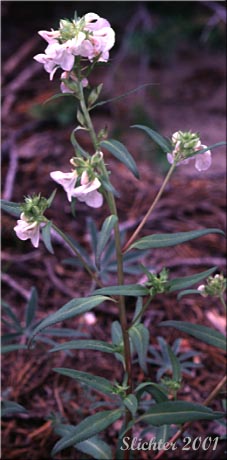 The
photo at right shows sickle-top lousewort from Bird Creek Meadows, Mt. Adams........August
8, 1990.
The
photo at right shows sickle-top lousewort from Bird Creek Meadows, Mt. Adams........August
8, 1990.
Leafy lousewort is a perennial wildflower with one to several simple to branched stems arising from 15-50 cm high. The herbage throughout is glabrous. All the leaves are found on the stems, and these range from 3-8 cm long and 4-10 mm wide. The simple blades are narrowly lanceolate with many small, angular to rounded teeth along the margins.
The inflorescence is a fairly loose raceme with leaf-like bracts below the flowers, The calyx is 5-7.5 mm long with 2 obliquely ovate lobes from 1.5-3 mm long. The calyx is more deeply cleft in front than in back. The corollas are white or pale yellow or occasionally pale purple. The upper lip is strongly curved downward to become somewhat sickle-shaped, the distal end eventually pointing back to the lower lip. The lower lip is about 5 mm long with 3 lobes, the middle lobe small while the outer lobes are wide and rounded.
Variety alba: This variety has white to light yellow flowers and leaves that are slightly narrower. It is found from the eastern Cascades and Sierra Nevada east to the Rocky Mts.
Variety racemosa: This variety has pink to purplish flowers and leaves that are slightly wider. It is found in the Cascades and northern Sierra Nevada westward to the Pacific coast.
Sickle-top lousewort is a common wildflower of coniferous woods at middle to high elevations in the mountains. It may also be found in dry meadows or on open slopes.
Sickle-top lousewort is found from from southern British Columbia south through the Cascade Mts. to northern California and east to Alberta and then southward through the Rocky Mts. to New Mexico.
In the Columbia River Gorge it is found between the elevations of 1600'-4600' in the western Gorge.